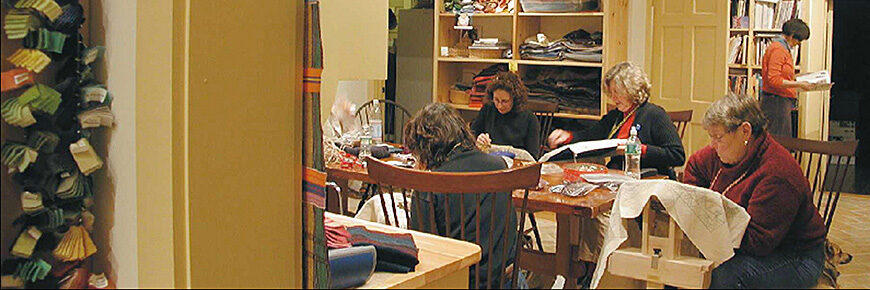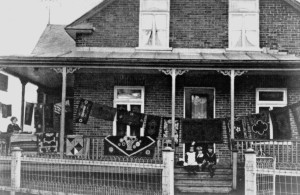The history behind rug hooking is speculative, at best. Some believe that the floor mats made in Yorkshire, England during the early part of the 19th century were the beginnings of hooked rugs. Workers in weaving mills were allowed to collect “thrums”, pieces of yarn that ran 9 inches long. These by-products were useless to the mill, and the weavers took them home and pulled the thrums through a backing. The origins of the word thrum are ancient, and a reference can be found in Shakespeare’s Merry Wives of Windsor.
Hooking rugs in North America probably began in New England and the Canadian Maritime Provinces in first quarter of the 19th century. During this period, wealthy Americans were importing carpets and less wealthy women began to fashion their own floor coverings from leftover fabric and later store bought fabrics cut into long strips specifically for that purpose. This was a period when Americans were beginning to have the time and money needed to decorate their homes (as opposed to just having a livable home and spending all of their time with necessities). Because floor coverings were popular with the wealthy, everyone wanted them. Prior to the 1860s, the lady making the rug designed the great majority of hooked rug designs.
In 1864, Edward Sands Frost, of Maine began stenciling hooked-rug designs, which he sold from a peddler’s cart. By the time he retired in 1876, he had cut about 750 stencils, which are now owned by the Henry Ford Museum and Greenfield Village. His designs included lions, tigers, leopards, dogs, cats, birds, deer, floral patterns, and patterns adapted from Oriental rugs.
Rug hooking stayed popular into the mid-20th century. The great majority of the rugs we find today sold as “antiques” were made between 1900 and 1950. These are more properly called “vintage” because “antique” has a legal definition of something that is 100 years old or older. The legal definition was created for importation duty purposes.
Hooked rugs were originally created as floor coverings. They became popular as wall hangings in the 1970s when American Country Antique collecting was at its height. These rugs offer wonderfully colorful graphics. Because most are less than 5 feet long, they offer great wall decorations. Because they are built upon loosely woven burlap, antique and vintage rugs do not wear as well as Oriental rugs. Old rugs should not be displayed on the floor unless it is an area with very little traffic. They are best displayed sewn to fabric that has been attached to a wooden stretcher and hung on the wall, or laid onto a table. Cleaning should be kept to a minimum, vacuuming should be with a hose attachment without a beater and it is best to cover the attachment with thinly woven fabric.

